Big Data Technologies for Business Intelligence: A Detailed Report
VerifiedAdded on 2023/06/08
|18
|4738
|137
Report
AI Summary
This report provides an in-depth analysis of big data's role in business intelligence, targeting executive business professionals with limited ICT knowledge. It begins with an executive summary and table of contents, followed by an introduction to big data concepts. The report then explores data collection and storage methods, including data collection systems and storage systems for big data. It delves into practical applications of big data, such as consumer-centric product design and recommendation systems. Finally, it examines business continuity strategies, particularly how online businesses can survive power outages and other disasters. The report incorporates extensive research and in-text referencing, offering a comprehensive overview of big data's benefits to businesses.

Running head: BUSINESS INTELLIGENCE USING BIG DATA
Business Intelligence using Big Data
Name of the student:
Name of the university:
Author Note
Business Intelligence using Big Data
Name of the student:
Name of the university:
Author Note
Paraphrase This Document
Need a fresh take? Get an instant paraphrase of this document with our AI Paraphraser
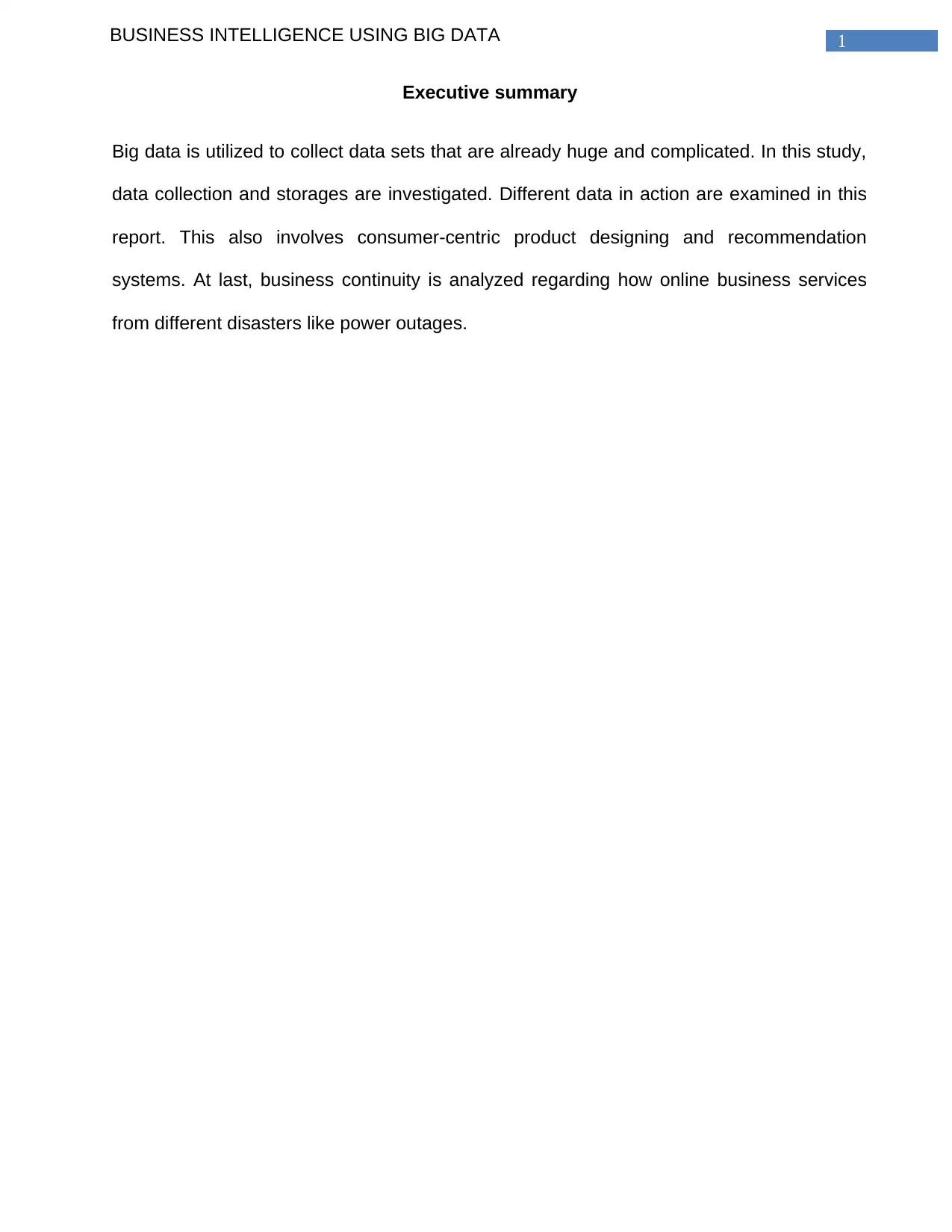
1BUSINESS INTELLIGENCE USING BIG DATA
Executive summary
Big data is utilized to collect data sets that are already huge and complicated. In this study,
data collection and storages are investigated. Different data in action are examined in this
report. This also involves consumer-centric product designing and recommendation
systems. At last, business continuity is analyzed regarding how online business services
from different disasters like power outages.
Executive summary
Big data is utilized to collect data sets that are already huge and complicated. In this study,
data collection and storages are investigated. Different data in action are examined in this
report. This also involves consumer-centric product designing and recommendation
systems. At last, business continuity is analyzed regarding how online business services
from different disasters like power outages.

2BUSINESS INTELLIGENCE USING BIG DATA
Table of Contents
Introduction:.............................................................................................................................3
1. Data Collection and Storage:..............................................................................................3
1.1. Data collection system:................................................................................................3
1.2. Storage system of big data:..........................................................................................4
2. Data in Action:.....................................................................................................................6
2.1. Consumer-centric product design:...............................................................................6
2.2. Recommendation system:............................................................................................8
3. Business continuity:............................................................................................................9
Conclusion:............................................................................................................................12
References:...........................................................................................................................14
Table of Contents
Introduction:.............................................................................................................................3
1. Data Collection and Storage:..............................................................................................3
1.1. Data collection system:................................................................................................3
1.2. Storage system of big data:..........................................................................................4
2. Data in Action:.....................................................................................................................6
2.1. Consumer-centric product design:...............................................................................6
2.2. Recommendation system:............................................................................................8
3. Business continuity:............................................................................................................9
Conclusion:............................................................................................................................12
References:...........................................................................................................................14
⊘ This is a preview!⊘
Do you want full access?
Subscribe today to unlock all pages.

Trusted by 1+ million students worldwide
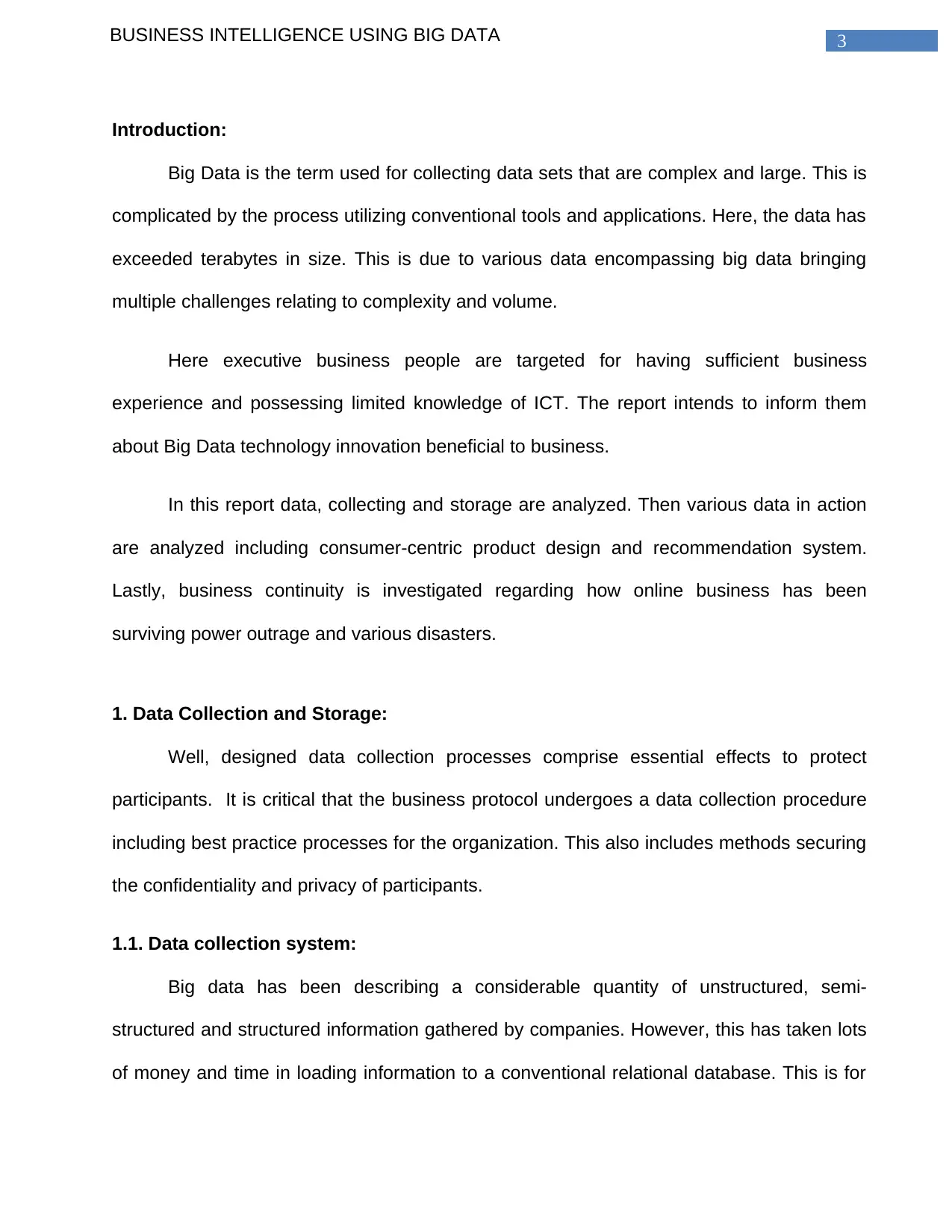
3BUSINESS INTELLIGENCE USING BIG DATA
Introduction:
Big Data is the term used for collecting data sets that are complex and large. This is
complicated by the process utilizing conventional tools and applications. Here, the data has
exceeded terabytes in size. This is due to various data encompassing big data bringing
multiple challenges relating to complexity and volume.
Here executive business people are targeted for having sufficient business
experience and possessing limited knowledge of ICT. The report intends to inform them
about Big Data technology innovation beneficial to business.
In this report data, collecting and storage are analyzed. Then various data in action
are analyzed including consumer-centric product design and recommendation system.
Lastly, business continuity is investigated regarding how online business has been
surviving power outrage and various disasters.
1. Data Collection and Storage:
Well, designed data collection processes comprise essential effects to protect
participants. It is critical that the business protocol undergoes a data collection procedure
including best practice processes for the organization. This also includes methods securing
the confidentiality and privacy of participants.
1.1. Data collection system:
Big data has been describing a considerable quantity of unstructured, semi-
structured and structured information gathered by companies. However, this has taken lots
of money and time in loading information to a conventional relational database. This is for
Introduction:
Big Data is the term used for collecting data sets that are complex and large. This is
complicated by the process utilizing conventional tools and applications. Here, the data has
exceeded terabytes in size. This is due to various data encompassing big data bringing
multiple challenges relating to complexity and volume.
Here executive business people are targeted for having sufficient business
experience and possessing limited knowledge of ICT. The report intends to inform them
about Big Data technology innovation beneficial to business.
In this report data, collecting and storage are analyzed. Then various data in action
are analyzed including consumer-centric product design and recommendation system.
Lastly, business continuity is investigated regarding how online business has been
surviving power outrage and various disasters.
1. Data Collection and Storage:
Well, designed data collection processes comprise essential effects to protect
participants. It is critical that the business protocol undergoes a data collection procedure
including best practice processes for the organization. This also includes methods securing
the confidentiality and privacy of participants.
1.1. Data collection system:
Big data has been describing a considerable quantity of unstructured, semi-
structured and structured information gathered by companies. However, this has taken lots
of money and time in loading information to a conventional relational database. This is for
Paraphrase This Document
Need a fresh take? Get an instant paraphrase of this document with our AI Paraphraser
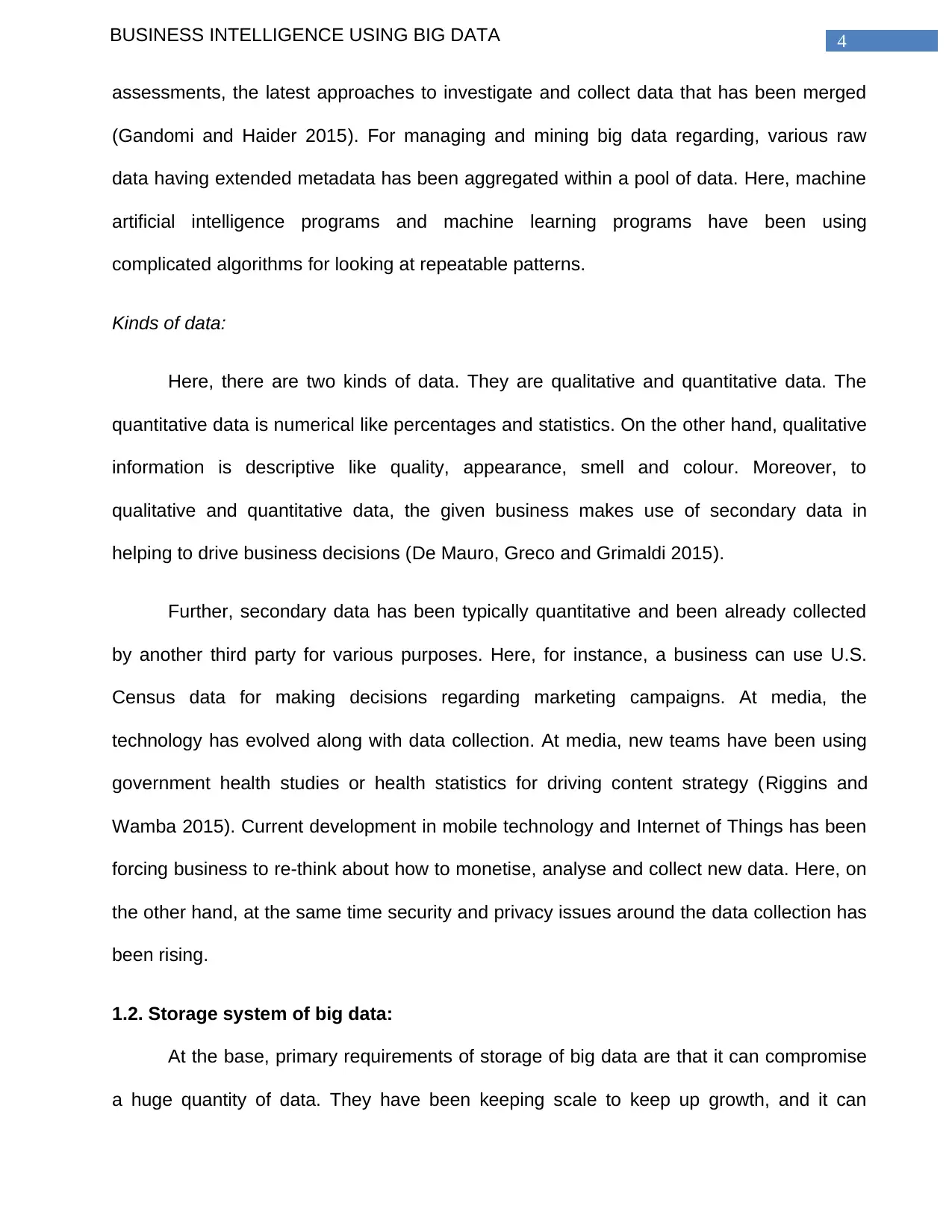
4BUSINESS INTELLIGENCE USING BIG DATA
assessments, the latest approaches to investigate and collect data that has been merged
(Gandomi and Haider 2015). For managing and mining big data regarding, various raw
data having extended metadata has been aggregated within a pool of data. Here, machine
artificial intelligence programs and machine learning programs have been using
complicated algorithms for looking at repeatable patterns.
Kinds of data:
Here, there are two kinds of data. They are qualitative and quantitative data. The
quantitative data is numerical like percentages and statistics. On the other hand, qualitative
information is descriptive like quality, appearance, smell and colour. Moreover, to
qualitative and quantitative data, the given business makes use of secondary data in
helping to drive business decisions (De Mauro, Greco and Grimaldi 2015).
Further, secondary data has been typically quantitative and been already collected
by another third party for various purposes. Here, for instance, a business can use U.S.
Census data for making decisions regarding marketing campaigns. At media, the
technology has evolved along with data collection. At media, new teams have been using
government health studies or health statistics for driving content strategy (Riggins and
Wamba 2015). Current development in mobile technology and Internet of Things has been
forcing business to re-think about how to monetise, analyse and collect new data. Here, on
the other hand, at the same time security and privacy issues around the data collection has
been rising.
1.2. Storage system of big data:
At the base, primary requirements of storage of big data are that it can compromise
a huge quantity of data. They have been keeping scale to keep up growth, and it can
assessments, the latest approaches to investigate and collect data that has been merged
(Gandomi and Haider 2015). For managing and mining big data regarding, various raw
data having extended metadata has been aggregated within a pool of data. Here, machine
artificial intelligence programs and machine learning programs have been using
complicated algorithms for looking at repeatable patterns.
Kinds of data:
Here, there are two kinds of data. They are qualitative and quantitative data. The
quantitative data is numerical like percentages and statistics. On the other hand, qualitative
information is descriptive like quality, appearance, smell and colour. Moreover, to
qualitative and quantitative data, the given business makes use of secondary data in
helping to drive business decisions (De Mauro, Greco and Grimaldi 2015).
Further, secondary data has been typically quantitative and been already collected
by another third party for various purposes. Here, for instance, a business can use U.S.
Census data for making decisions regarding marketing campaigns. At media, the
technology has evolved along with data collection. At media, new teams have been using
government health studies or health statistics for driving content strategy (Riggins and
Wamba 2015). Current development in mobile technology and Internet of Things has been
forcing business to re-think about how to monetise, analyse and collect new data. Here, on
the other hand, at the same time security and privacy issues around the data collection has
been rising.
1.2. Storage system of big data:
At the base, primary requirements of storage of big data are that it can compromise
a huge quantity of data. They have been keeping scale to keep up growth, and it can
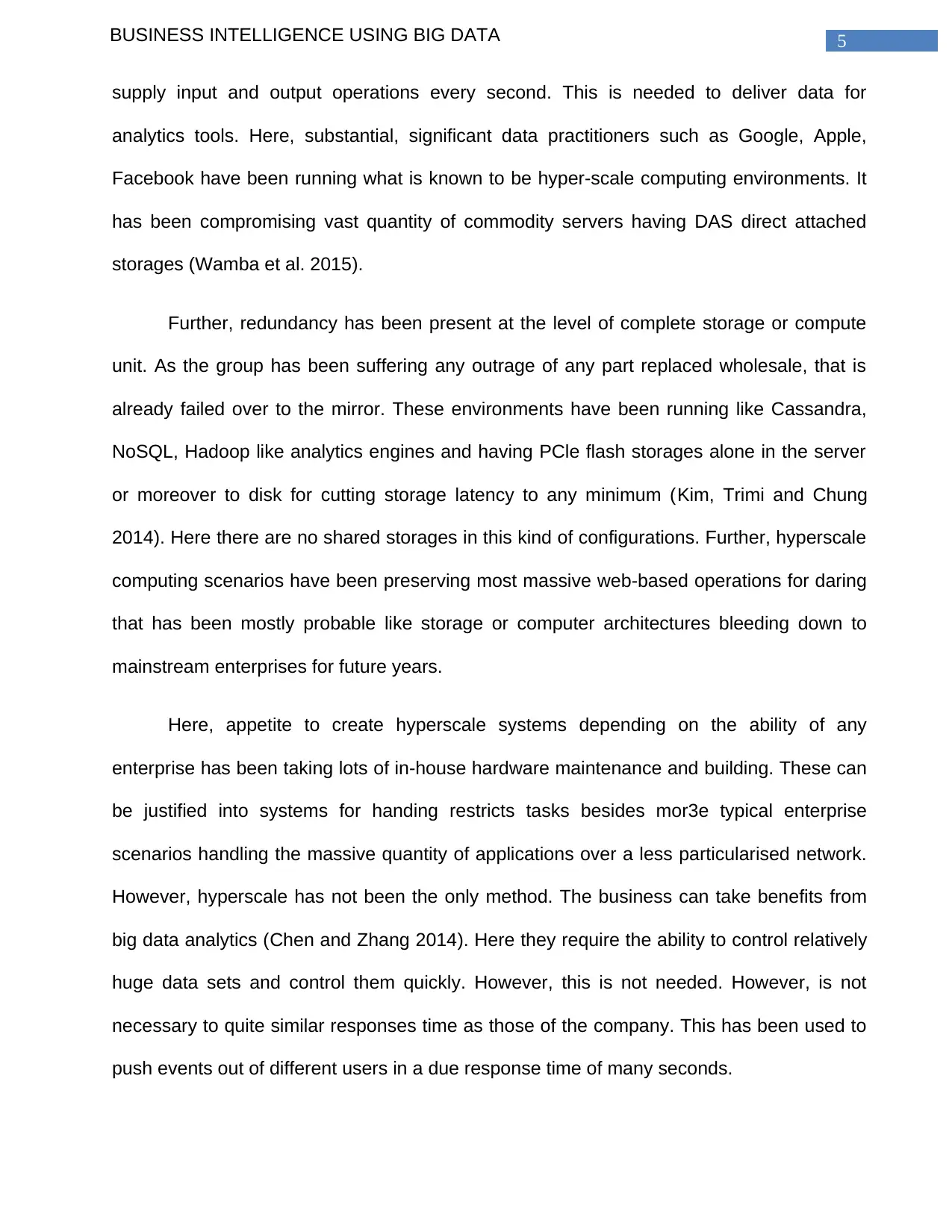
5BUSINESS INTELLIGENCE USING BIG DATA
supply input and output operations every second. This is needed to deliver data for
analytics tools. Here, substantial, significant data practitioners such as Google, Apple,
Facebook have been running what is known to be hyper-scale computing environments. It
has been compromising vast quantity of commodity servers having DAS direct attached
storages (Wamba et al. 2015).
Further, redundancy has been present at the level of complete storage or compute
unit. As the group has been suffering any outrage of any part replaced wholesale, that is
already failed over to the mirror. These environments have been running like Cassandra,
NoSQL, Hadoop like analytics engines and having PCle flash storages alone in the server
or moreover to disk for cutting storage latency to any minimum (Kim, Trimi and Chung
2014). Here there are no shared storages in this kind of configurations. Further, hyperscale
computing scenarios have been preserving most massive web-based operations for daring
that has been mostly probable like storage or computer architectures bleeding down to
mainstream enterprises for future years.
Here, appetite to create hyperscale systems depending on the ability of any
enterprise has been taking lots of in-house hardware maintenance and building. These can
be justified into systems for handing restricts tasks besides mor3e typical enterprise
scenarios handling the massive quantity of applications over a less particularised network.
However, hyperscale has not been the only method. The business can take benefits from
big data analytics (Chen and Zhang 2014). Here they require the ability to control relatively
huge data sets and control them quickly. However, this is not needed. However, is not
necessary to quite similar responses time as those of the company. This has been used to
push events out of different users in a due response time of many seconds.
supply input and output operations every second. This is needed to deliver data for
analytics tools. Here, substantial, significant data practitioners such as Google, Apple,
Facebook have been running what is known to be hyper-scale computing environments. It
has been compromising vast quantity of commodity servers having DAS direct attached
storages (Wamba et al. 2015).
Further, redundancy has been present at the level of complete storage or compute
unit. As the group has been suffering any outrage of any part replaced wholesale, that is
already failed over to the mirror. These environments have been running like Cassandra,
NoSQL, Hadoop like analytics engines and having PCle flash storages alone in the server
or moreover to disk for cutting storage latency to any minimum (Kim, Trimi and Chung
2014). Here there are no shared storages in this kind of configurations. Further, hyperscale
computing scenarios have been preserving most massive web-based operations for daring
that has been mostly probable like storage or computer architectures bleeding down to
mainstream enterprises for future years.
Here, appetite to create hyperscale systems depending on the ability of any
enterprise has been taking lots of in-house hardware maintenance and building. These can
be justified into systems for handing restricts tasks besides mor3e typical enterprise
scenarios handling the massive quantity of applications over a less particularised network.
However, hyperscale has not been the only method. The business can take benefits from
big data analytics (Chen and Zhang 2014). Here they require the ability to control relatively
huge data sets and control them quickly. However, this is not needed. However, is not
necessary to quite similar responses time as those of the company. This has been used to
push events out of different users in a due response time of many seconds.
⊘ This is a preview!⊘
Do you want full access?
Subscribe today to unlock all pages.

Trusted by 1+ million students worldwide
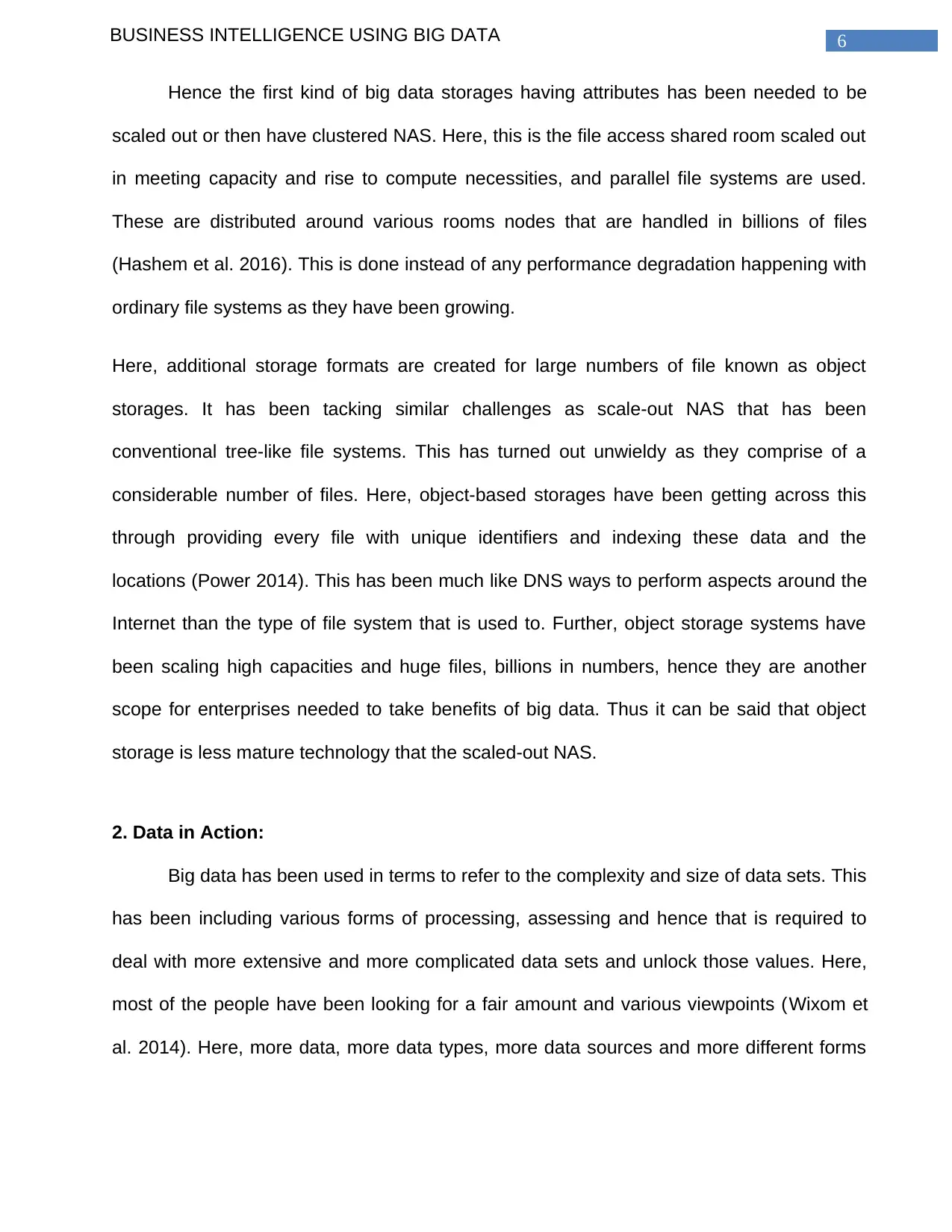
6BUSINESS INTELLIGENCE USING BIG DATA
Hence the first kind of big data storages having attributes has been needed to be
scaled out or then have clustered NAS. Here, this is the file access shared room scaled out
in meeting capacity and rise to compute necessities, and parallel file systems are used.
These are distributed around various rooms nodes that are handled in billions of files
(Hashem et al. 2016). This is done instead of any performance degradation happening with
ordinary file systems as they have been growing.
Here, additional storage formats are created for large numbers of file known as object
storages. It has been tacking similar challenges as scale-out NAS that has been
conventional tree-like file systems. This has turned out unwieldy as they comprise of a
considerable number of files. Here, object-based storages have been getting across this
through providing every file with unique identifiers and indexing these data and the
locations (Power 2014). This has been much like DNS ways to perform aspects around the
Internet than the type of file system that is used to. Further, object storage systems have
been scaling high capacities and huge files, billions in numbers, hence they are another
scope for enterprises needed to take benefits of big data. Thus it can be said that object
storage is less mature technology that the scaled-out NAS.
2. Data in Action:
Big data has been used in terms to refer to the complexity and size of data sets. This
has been including various forms of processing, assessing and hence that is required to
deal with more extensive and more complicated data sets and unlock those values. Here,
most of the people have been looking for a fair amount and various viewpoints (Wixom et
al. 2014). Here, more data, more data types, more data sources and more different forms
Hence the first kind of big data storages having attributes has been needed to be
scaled out or then have clustered NAS. Here, this is the file access shared room scaled out
in meeting capacity and rise to compute necessities, and parallel file systems are used.
These are distributed around various rooms nodes that are handled in billions of files
(Hashem et al. 2016). This is done instead of any performance degradation happening with
ordinary file systems as they have been growing.
Here, additional storage formats are created for large numbers of file known as object
storages. It has been tacking similar challenges as scale-out NAS that has been
conventional tree-like file systems. This has turned out unwieldy as they comprise of a
considerable number of files. Here, object-based storages have been getting across this
through providing every file with unique identifiers and indexing these data and the
locations (Power 2014). This has been much like DNS ways to perform aspects around the
Internet than the type of file system that is used to. Further, object storage systems have
been scaling high capacities and huge files, billions in numbers, hence they are another
scope for enterprises needed to take benefits of big data. Thus it can be said that object
storage is less mature technology that the scaled-out NAS.
2. Data in Action:
Big data has been used in terms to refer to the complexity and size of data sets. This
has been including various forms of processing, assessing and hence that is required to
deal with more extensive and more complicated data sets and unlock those values. Here,
most of the people have been looking for a fair amount and various viewpoints (Wixom et
al. 2014). Here, more data, more data types, more data sources and more different forms
Paraphrase This Document
Need a fresh take? Get an instant paraphrase of this document with our AI Paraphraser
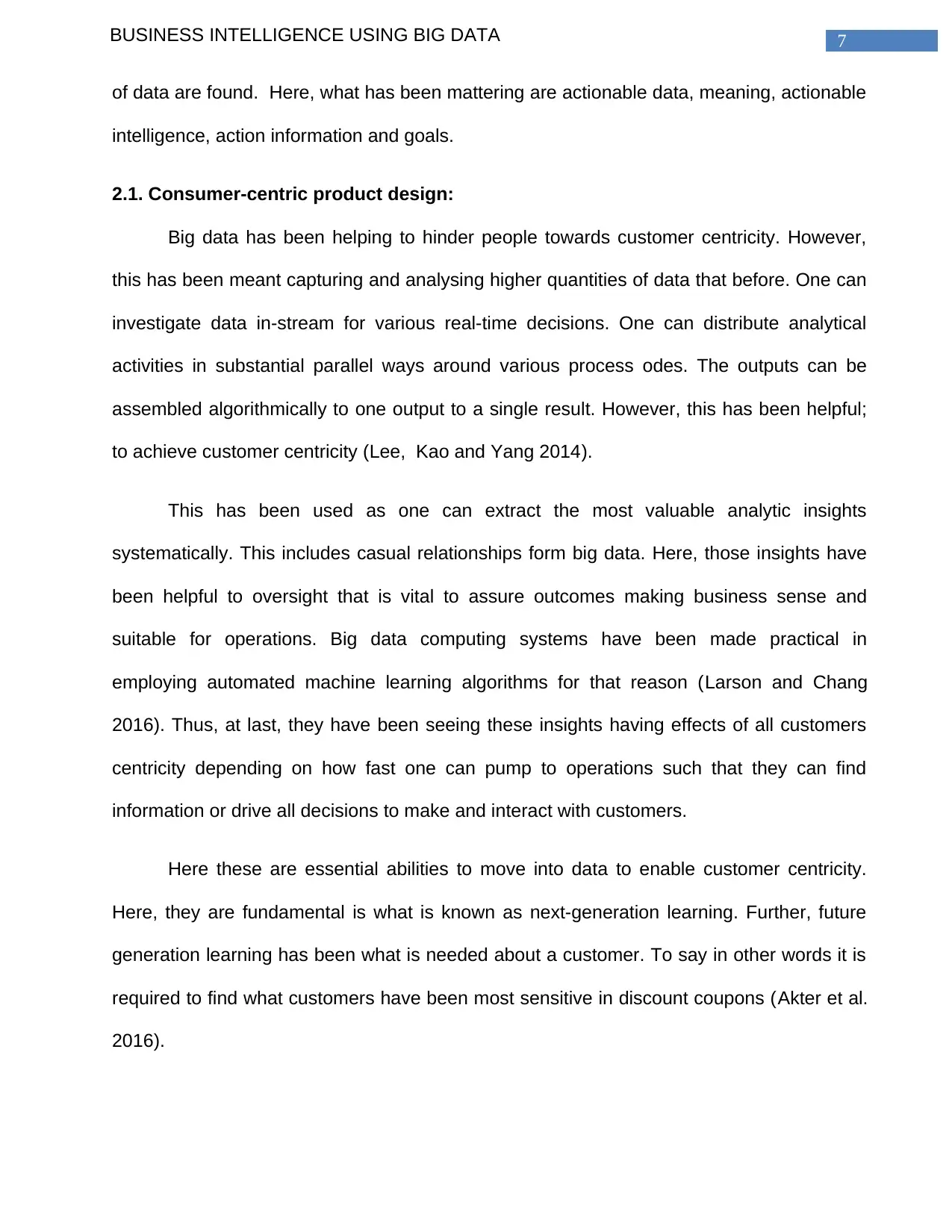
7BUSINESS INTELLIGENCE USING BIG DATA
of data are found. Here, what has been mattering are actionable data, meaning, actionable
intelligence, action information and goals.
2.1. Consumer-centric product design:
Big data has been helping to hinder people towards customer centricity. However,
this has been meant capturing and analysing higher quantities of data that before. One can
investigate data in-stream for various real-time decisions. One can distribute analytical
activities in substantial parallel ways around various process odes. The outputs can be
assembled algorithmically to one output to a single result. However, this has been helpful;
to achieve customer centricity (Lee, Kao and Yang 2014).
This has been used as one can extract the most valuable analytic insights
systematically. This includes casual relationships form big data. Here, those insights have
been helpful to oversight that is vital to assure outcomes making business sense and
suitable for operations. Big data computing systems have been made practical in
employing automated machine learning algorithms for that reason (Larson and Chang
2016). Thus, at last, they have been seeing these insights having effects of all customers
centricity depending on how fast one can pump to operations such that they can find
information or drive all decisions to make and interact with customers.
Here these are essential abilities to move into data to enable customer centricity.
Here, they are fundamental is what is known as next-generation learning. Further, future
generation learning has been what is needed about a customer. To say in other words it is
required to find what customers have been most sensitive in discount coupons (Akter et al.
2016).
of data are found. Here, what has been mattering are actionable data, meaning, actionable
intelligence, action information and goals.
2.1. Consumer-centric product design:
Big data has been helping to hinder people towards customer centricity. However,
this has been meant capturing and analysing higher quantities of data that before. One can
investigate data in-stream for various real-time decisions. One can distribute analytical
activities in substantial parallel ways around various process odes. The outputs can be
assembled algorithmically to one output to a single result. However, this has been helpful;
to achieve customer centricity (Lee, Kao and Yang 2014).
This has been used as one can extract the most valuable analytic insights
systematically. This includes casual relationships form big data. Here, those insights have
been helpful to oversight that is vital to assure outcomes making business sense and
suitable for operations. Big data computing systems have been made practical in
employing automated machine learning algorithms for that reason (Larson and Chang
2016). Thus, at last, they have been seeing these insights having effects of all customers
centricity depending on how fast one can pump to operations such that they can find
information or drive all decisions to make and interact with customers.
Here these are essential abilities to move into data to enable customer centricity.
Here, they are fundamental is what is known as next-generation learning. Further, future
generation learning has been what is needed about a customer. To say in other words it is
required to find what customers have been most sensitive in discount coupons (Akter et al.
2016).

8BUSINESS INTELLIGENCE USING BIG DATA
Here, an issue with big data has been applying proper analytic tools for business
data on extracting values. Organizations must be applying decent statistical models to
those data making better sense of data and consequently getting more amount of value
from that information. Here business data can be distinguished into four kinds. They are
operational, financial, constituencies and customers. Further, businesses have been
adopting customer-centric programs for helping to develop how they can control customer
relationships (Xu, Frankwick and Ramirez 2016). Here, the plans have been falling under
various names. However, they have been serving the same type of functions. This is to
make customers successfully with solutions that cane purchased. Thus they have been
buying such that they have received more values from them. This to make them engaged in
more loyal behaviours towards the brands. This is to retention, purchases and
recommended. Thus two popular customer-centric processes are known as CSM or
customer success management or customer experience management or CXM.
Here, businesses have realised the value to integrate distinct kinds of customer data
for improving the loyalty of customers. Here, the research on various best practices in
customer programs. Here, the study has been on best practices to customer programs.
This is also found that the integration of several types of customer data (Xiang et al. 2015).
This includes satisfaction, values, service history and purchase history. Here the necessity
for an active program of customer feedback is needed.
Thus mainly it is found that loyalty leading companies. This is compared to
allegiance lagging counterparts, linking customers in several of business metrics. Like
operational, financial and constituency for uncovering more profound many insights of more
profound (Phillips-Wren et al. 2015). Moreover in facilitating the integration that has been
Here, an issue with big data has been applying proper analytic tools for business
data on extracting values. Organizations must be applying decent statistical models to
those data making better sense of data and consequently getting more amount of value
from that information. Here business data can be distinguished into four kinds. They are
operational, financial, constituencies and customers. Further, businesses have been
adopting customer-centric programs for helping to develop how they can control customer
relationships (Xu, Frankwick and Ramirez 2016). Here, the plans have been falling under
various names. However, they have been serving the same type of functions. This is to
make customers successfully with solutions that cane purchased. Thus they have been
buying such that they have received more values from them. This to make them engaged in
more loyal behaviours towards the brands. This is to retention, purchases and
recommended. Thus two popular customer-centric processes are known as CSM or
customer success management or customer experience management or CXM.
Here, businesses have realised the value to integrate distinct kinds of customer data
for improving the loyalty of customers. Here, the research on various best practices in
customer programs. Here, the study has been on best practices to customer programs.
This is also found that the integration of several types of customer data (Xiang et al. 2015).
This includes satisfaction, values, service history and purchase history. Here the necessity
for an active program of customer feedback is needed.
Thus mainly it is found that loyalty leading companies. This is compared to
allegiance lagging counterparts, linking customers in several of business metrics. Like
operational, financial and constituency for uncovering more profound many insights of more
profound (Phillips-Wren et al. 2015). Moreover in facilitating the integration that has been
⊘ This is a preview!⊘
Do you want full access?
Subscribe today to unlock all pages.

Trusted by 1+ million students worldwide
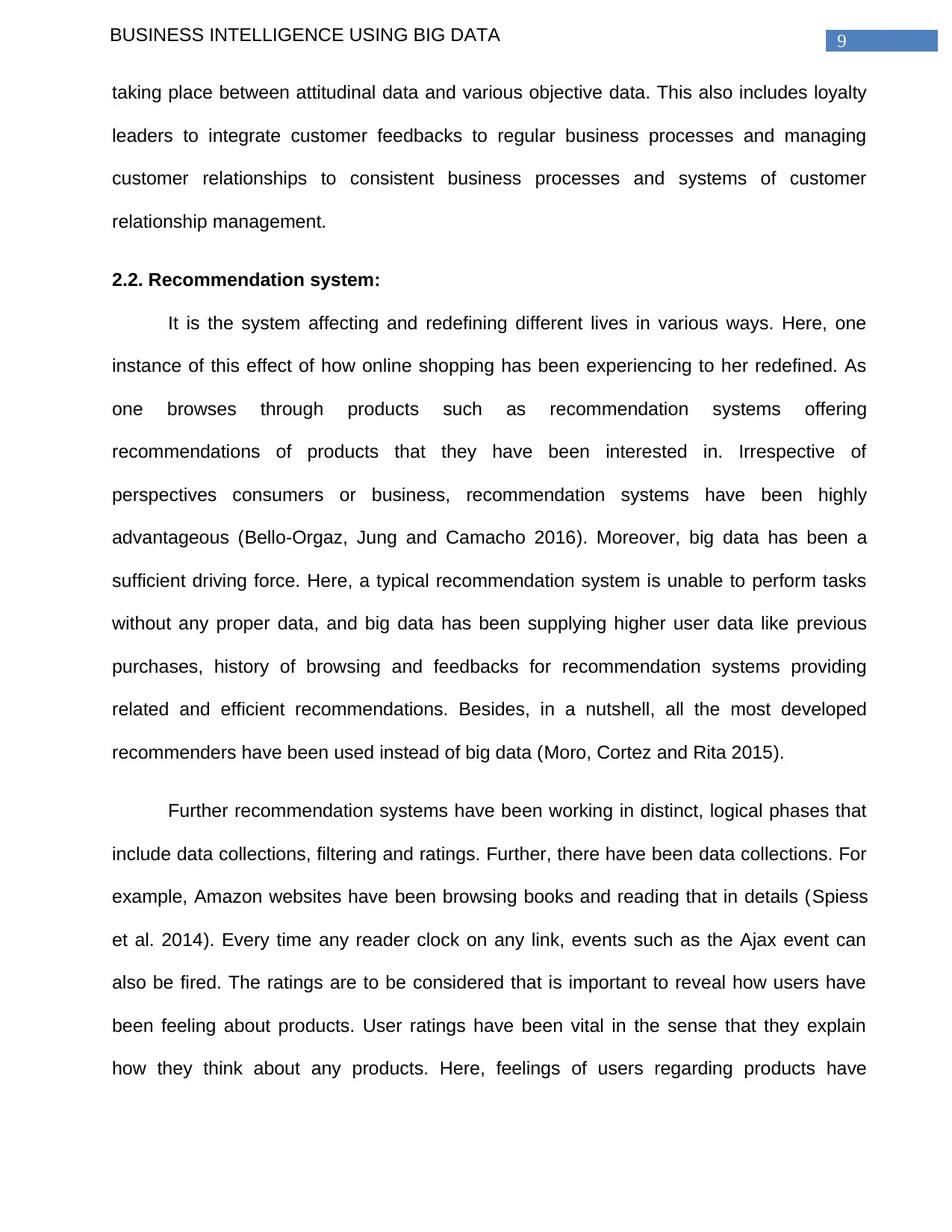
9BUSINESS INTELLIGENCE USING BIG DATA
taking place between attitudinal data and various objective data. This also includes loyalty
leaders to integrate customer feedbacks to regular business processes and managing
customer relationships to consistent business processes and systems of customer
relationship management.
2.2. Recommendation system:
It is the system affecting and redefining different lives in various ways. Here, one
instance of this effect of how online shopping has been experiencing to her redefined. As
one browses through products such as recommendation systems offering
recommendations of products that they have been interested in. Irrespective of
perspectives consumers or business, recommendation systems have been highly
advantageous (Bello-Orgaz, Jung and Camacho 2016). Moreover, big data has been a
sufficient driving force. Here, a typical recommendation system is unable to perform tasks
without any proper data, and big data has been supplying higher user data like previous
purchases, history of browsing and feedbacks for recommendation systems providing
related and efficient recommendations. Besides, in a nutshell, all the most developed
recommenders have been used instead of big data (Moro, Cortez and Rita 2015).
Further recommendation systems have been working in distinct, logical phases that
include data collections, filtering and ratings. Further, there have been data collections. For
example, Amazon websites have been browsing books and reading that in details (Spiess
et al. 2014). Every time any reader clock on any link, events such as the Ajax event can
also be fired. The ratings are to be considered that is important to reveal how users have
been feeling about products. User ratings have been vital in the sense that they explain
how they think about any products. Here, feelings of users regarding products have
taking place between attitudinal data and various objective data. This also includes loyalty
leaders to integrate customer feedbacks to regular business processes and managing
customer relationships to consistent business processes and systems of customer
relationship management.
2.2. Recommendation system:
It is the system affecting and redefining different lives in various ways. Here, one
instance of this effect of how online shopping has been experiencing to her redefined. As
one browses through products such as recommendation systems offering
recommendations of products that they have been interested in. Irrespective of
perspectives consumers or business, recommendation systems have been highly
advantageous (Bello-Orgaz, Jung and Camacho 2016). Moreover, big data has been a
sufficient driving force. Here, a typical recommendation system is unable to perform tasks
without any proper data, and big data has been supplying higher user data like previous
purchases, history of browsing and feedbacks for recommendation systems providing
related and efficient recommendations. Besides, in a nutshell, all the most developed
recommenders have been used instead of big data (Moro, Cortez and Rita 2015).
Further recommendation systems have been working in distinct, logical phases that
include data collections, filtering and ratings. Further, there have been data collections. For
example, Amazon websites have been browsing books and reading that in details (Spiess
et al. 2014). Every time any reader clock on any link, events such as the Ajax event can
also be fired. The ratings are to be considered that is important to reveal how users have
been feeling about products. User ratings have been vital in the sense that they explain
how they think about any products. Here, feelings of users regarding products have
Paraphrase This Document
Need a fresh take? Get an instant paraphrase of this document with our AI Paraphraser
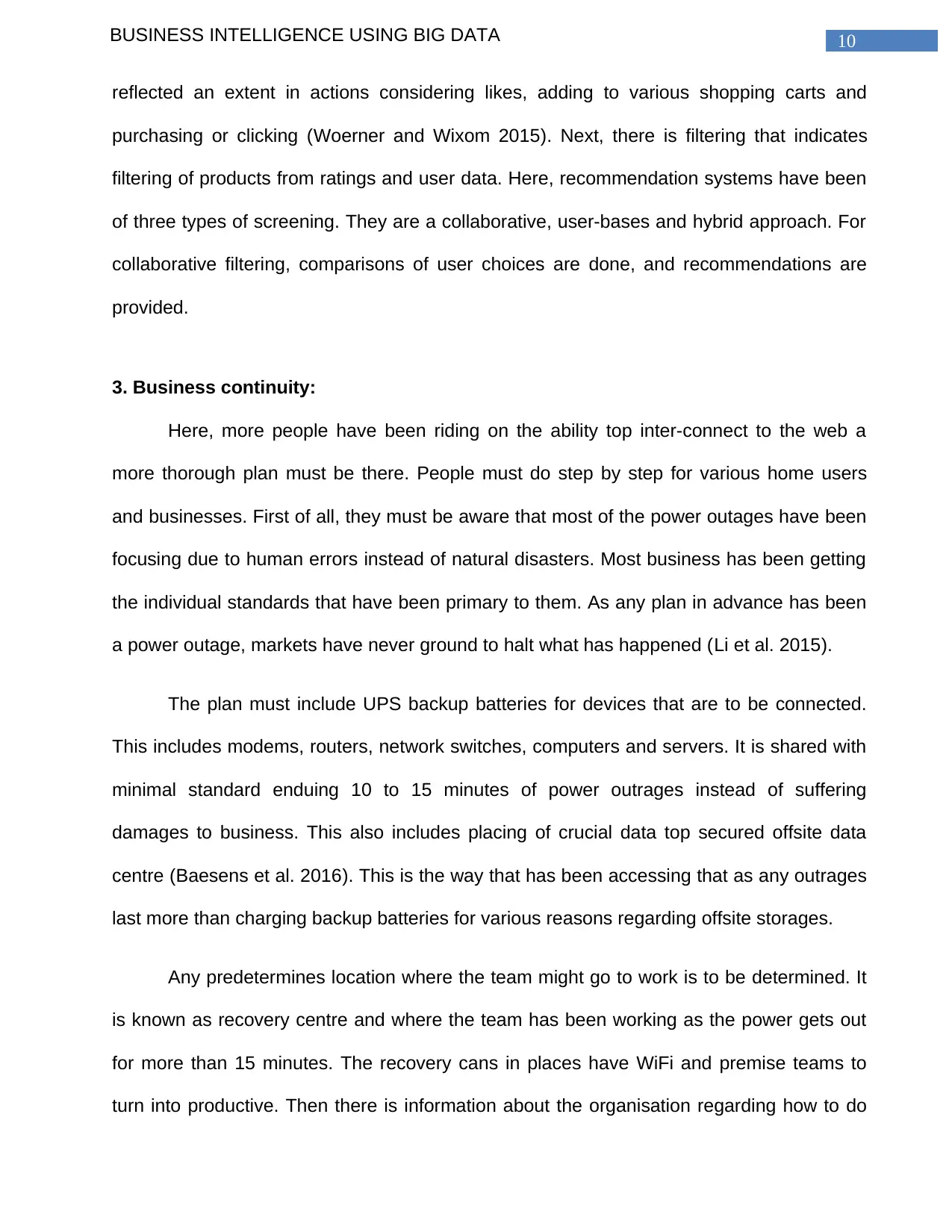
10BUSINESS INTELLIGENCE USING BIG DATA
reflected an extent in actions considering likes, adding to various shopping carts and
purchasing or clicking (Woerner and Wixom 2015). Next, there is filtering that indicates
filtering of products from ratings and user data. Here, recommendation systems have been
of three types of screening. They are a collaborative, user-bases and hybrid approach. For
collaborative filtering, comparisons of user choices are done, and recommendations are
provided.
3. Business continuity:
Here, more people have been riding on the ability top inter-connect to the web a
more thorough plan must be there. People must do step by step for various home users
and businesses. First of all, they must be aware that most of the power outages have been
focusing due to human errors instead of natural disasters. Most business has been getting
the individual standards that have been primary to them. As any plan in advance has been
a power outage, markets have never ground to halt what has happened (Li et al. 2015).
The plan must include UPS backup batteries for devices that are to be connected.
This includes modems, routers, network switches, computers and servers. It is shared with
minimal standard enduing 10 to 15 minutes of power outrages instead of suffering
damages to business. This also includes placing of crucial data top secured offsite data
centre (Baesens et al. 2016). This is the way that has been accessing that as any outrages
last more than charging backup batteries for various reasons regarding offsite storages.
Any predetermines location where the team might go to work is to be determined. It
is known as recovery centre and where the team has been working as the power gets out
for more than 15 minutes. The recovery cans in places have WiFi and premise teams to
turn into productive. Then there is information about the organisation regarding how to do
reflected an extent in actions considering likes, adding to various shopping carts and
purchasing or clicking (Woerner and Wixom 2015). Next, there is filtering that indicates
filtering of products from ratings and user data. Here, recommendation systems have been
of three types of screening. They are a collaborative, user-bases and hybrid approach. For
collaborative filtering, comparisons of user choices are done, and recommendations are
provided.
3. Business continuity:
Here, more people have been riding on the ability top inter-connect to the web a
more thorough plan must be there. People must do step by step for various home users
and businesses. First of all, they must be aware that most of the power outages have been
focusing due to human errors instead of natural disasters. Most business has been getting
the individual standards that have been primary to them. As any plan in advance has been
a power outage, markets have never ground to halt what has happened (Li et al. 2015).
The plan must include UPS backup batteries for devices that are to be connected.
This includes modems, routers, network switches, computers and servers. It is shared with
minimal standard enduing 10 to 15 minutes of power outrages instead of suffering
damages to business. This also includes placing of crucial data top secured offsite data
centre (Baesens et al. 2016). This is the way that has been accessing that as any outrages
last more than charging backup batteries for various reasons regarding offsite storages.
Any predetermines location where the team might go to work is to be determined. It
is known as recovery centre and where the team has been working as the power gets out
for more than 15 minutes. The recovery cans in places have WiFi and premise teams to
turn into productive. Then there is information about the organisation regarding how to do

11BUSINESS INTELLIGENCE USING BIG DATA
tasks while any outrage goes on. Here, the policy has included things such as quickly
saving works and shutting down needed apps and devices as the back-up to battery power
is active (Lu et al. 2015). This also provides tech tips such as how it has been possible to
speak over a cell phone and uses as a hotspot at the same time. This includes planning for
various power outrages as a part of comprehensive systems of business like DRP or
Disaster Recovery Plan. Multiple companies have failed due to disaster as they are not
planned well.
Testing is regarded as the most vital part of planning. Without this one cannot know
how to plan. Here, the time of trial has not been where they have dealt with outrages for the
first time. It is needed to be determined how outraging has been occurring, what length of
time has been required, whether everyone has been supposed to do that and productivity
has been affected. They should keep devices that are plugged in as they are never
charged up or prepared to move. They should keep a few charged portable battery charges
(Duan and Xiong 2015). Next, there are disasters. As most businesses have acknowledged
it, various surveys have revealed that out of a little number of originations have enough
protection the event of significant disruptions. Here, disaster recovery plans have been
saving several dollars in huge loses and worse during business closures. As one has never
heard much about DRs, they have been posting to help in gaining few insights regarding
what it has been and how it has been affecting future of business.
Moreover, unpredictability is a reality of life. As it is unclear and sufficiently
compelling business owners have been considering putting well-conceived disaster
recovery plans to places. This has been the time to provide some thoughts (Baesens et al.
2016). Performing that can save people during a business loss. Further, some helpful data
tasks while any outrage goes on. Here, the policy has included things such as quickly
saving works and shutting down needed apps and devices as the back-up to battery power
is active (Lu et al. 2015). This also provides tech tips such as how it has been possible to
speak over a cell phone and uses as a hotspot at the same time. This includes planning for
various power outrages as a part of comprehensive systems of business like DRP or
Disaster Recovery Plan. Multiple companies have failed due to disaster as they are not
planned well.
Testing is regarded as the most vital part of planning. Without this one cannot know
how to plan. Here, the time of trial has not been where they have dealt with outrages for the
first time. It is needed to be determined how outraging has been occurring, what length of
time has been required, whether everyone has been supposed to do that and productivity
has been affected. They should keep devices that are plugged in as they are never
charged up or prepared to move. They should keep a few charged portable battery charges
(Duan and Xiong 2015). Next, there are disasters. As most businesses have acknowledged
it, various surveys have revealed that out of a little number of originations have enough
protection the event of significant disruptions. Here, disaster recovery plans have been
saving several dollars in huge loses and worse during business closures. As one has never
heard much about DRs, they have been posting to help in gaining few insights regarding
what it has been and how it has been affecting future of business.
Moreover, unpredictability is a reality of life. As it is unclear and sufficiently
compelling business owners have been considering putting well-conceived disaster
recovery plans to places. This has been the time to provide some thoughts (Baesens et al.
2016). Performing that can save people during a business loss. Further, some helpful data
⊘ This is a preview!⊘
Do you want full access?
Subscribe today to unlock all pages.

Trusted by 1+ million students worldwide
1 out of 18
Related Documents
Your All-in-One AI-Powered Toolkit for Academic Success.
+13062052269
info@desklib.com
Available 24*7 on WhatsApp / Email
![[object Object]](/_next/static/media/star-bottom.7253800d.svg)
Unlock your academic potential
Copyright © 2020–2025 A2Z Services. All Rights Reserved. Developed and managed by ZUCOL.





